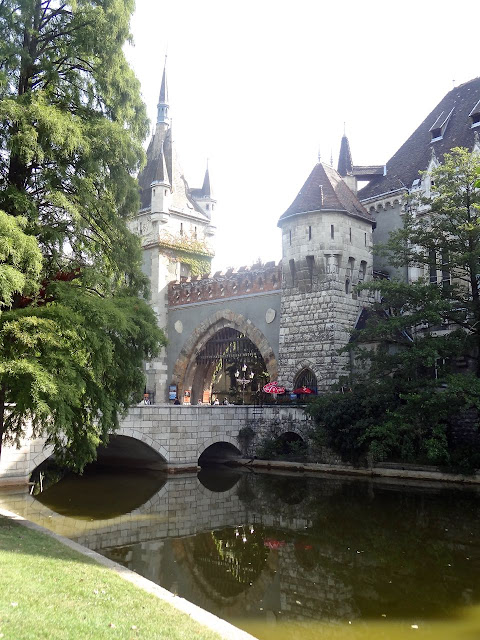Vajdahunyad castle was designed by Ignác Alpár to feature copies of several landmark buildings from different parts the Kingdom of Hungary, especially the Hunyad Castle in Transylvania now in Romania. As the castle contains parts of buildings from various time periods, it displays different architectural styles: Romanesque, Gothic, Renaissance, and Baroque. Originally, it was made from cardboard and wood, but it became so popular that it was rebuilt from stone and brick between 1904 and 1908. Today, it houses the Museum of Hungarian Agriculture, the biggest agricultural museum in Europe. Heroes' Square is one of the major squares in Budapest, Hungary, noted for its iconic statue complex featuring the Seven Chieftains of the Magyars and other important national leaders, as well as the Tomb of the Unknown Soldier. From the lush Buda hills, beautiful parks and heroic monuments to the gushing thermal springs on which the city stands, suggests that Budapest was formed by a god with a taste for the magnificent, and so we set off to explore some of the city's enigmatic sites.
The archangel Gabriel tops the central column of Heroes Square,
holding the Holy Crown and two-barred apostolic cross
Located at the end of Andrássy Avenue, Heroes Square is the entrance to the City Park as well as one of the most spectacular venues in Budapest. The three main sites of the square include the Hall of Art, built in 1896, the Museum of Fine Arts, inaugurated in December 1906, as well as the Millennium Monument, linking both buildings visually. The latter includes a 36-metre central column, topped by a statue of the archangel Gabriel who holds the Holy Crown as well as a two-barred apostolic cross, the same way as the founder of the Kingdom of Hungary, St. Stephen did in his sleep according to a legend. The crescent-shaped monument was built in Eclectic style. The semi-circular arcades of the monument on the left and right-hand side each hold bronze statues of seven outstanding personalities of Hungarian history.
Equestian statue of Árpád Göncz, the former President of Hungary
who had played a major role in the Hungarian Revolution of 1956
Seven leaders of the Magyar tribes, some of the most relevant figures of Hungarian history
Heroes Monument is formed of two semicircles which are adorned from above with various symbols: for peace and war, for work and wellbeing, for knowledge and glory
St. Stephen, the first King of Hungary from 1001 until his death in 1038
Allegorical statue of War
Watercolorist on the bridge overlooking Vajdahunyad Castle
The enchanting Vajdahunyad Castle with Gothic iron gate evocative of a medieval fortress
The bronze sculpture of 'Anonymous' in monk's habit with the cowl obscuring his face,
located in the courtyard of Budapest's Vajdahunyad Castle
The Romanesque Jak Chapel of Vajdahunyad Castle is a popular venue for weddings in Budapest
The Baroque facade of the Museum of Hungarian Agriculture
The castle, despite all appearances, was built in 1896, and is in fact a fantasy pastiche showcasing the architectural evolution through centuries and styles in Hungary
Vajdahunyad Castle viewed from the lake of the City Park
The castle features copies of several landmark buildings from different parts the Kingdom of Hungary, especially the Hunyad Castle in Transylvania which is now in Romania
Construction crews setting up chalet stalls for the upcoming Chocolate Festival
The neo-baroque Széchenyi Thermal Baths built in 1913 is immense with 15 indoor pools
and three outdoor, is one of the largest spa complexes in Europe
Ceiling decoration in the main hall of Apollo riding across the skies
The therapy and massage rooms
One of the outdoor thermal baths with the circular corridor that jettisons bathers around quite quickly to the delight of adults and children alike
The pools are fed from natural hot-springs made with calcium, magnesium, hydro-carbonate, and also contains sodium and sulphate, with a significant content in fluoride and metabolic acid
One of hot interior geothermal pools that goes up to a glorious 38°C
Thanks to its picturesque setting and stunning views all year long,
Robinson is justly named among the most romantic restaurants in town
And just minutes from the Széchenyi Themal Baths,
the restaurant could not have been better located for a post-spa lunch
Seated at a perfect table overlooking the lake, we felt very zen after our morning 'taking the waters' at Széchenyi and slowly looked over the Hungarian-Mediterranean influenced menu
A cold glass of Dreher was just heavenly
Even the duck were chilling out
Cold Green Pea Soup with radish, mint and creme fraiche
Traditional Hungarian Bouillon with cooked meat, dumplings and vegetables
Bufala Mozzarella Salad with Tomatoes, Basil Pesto and Baby Watercress
Spaghetti Bolognese with shaved parmigiana

































No comments:
Post a Comment